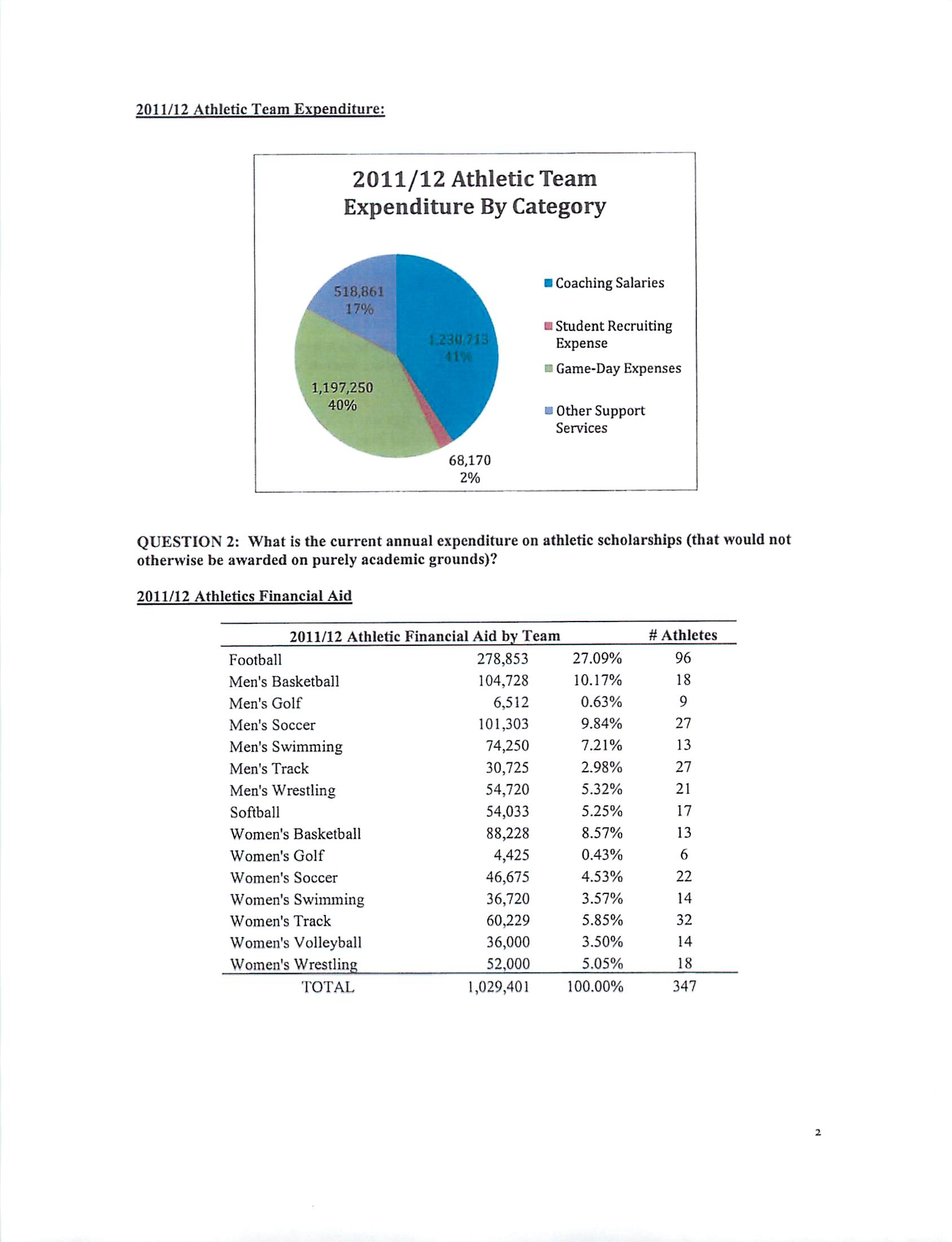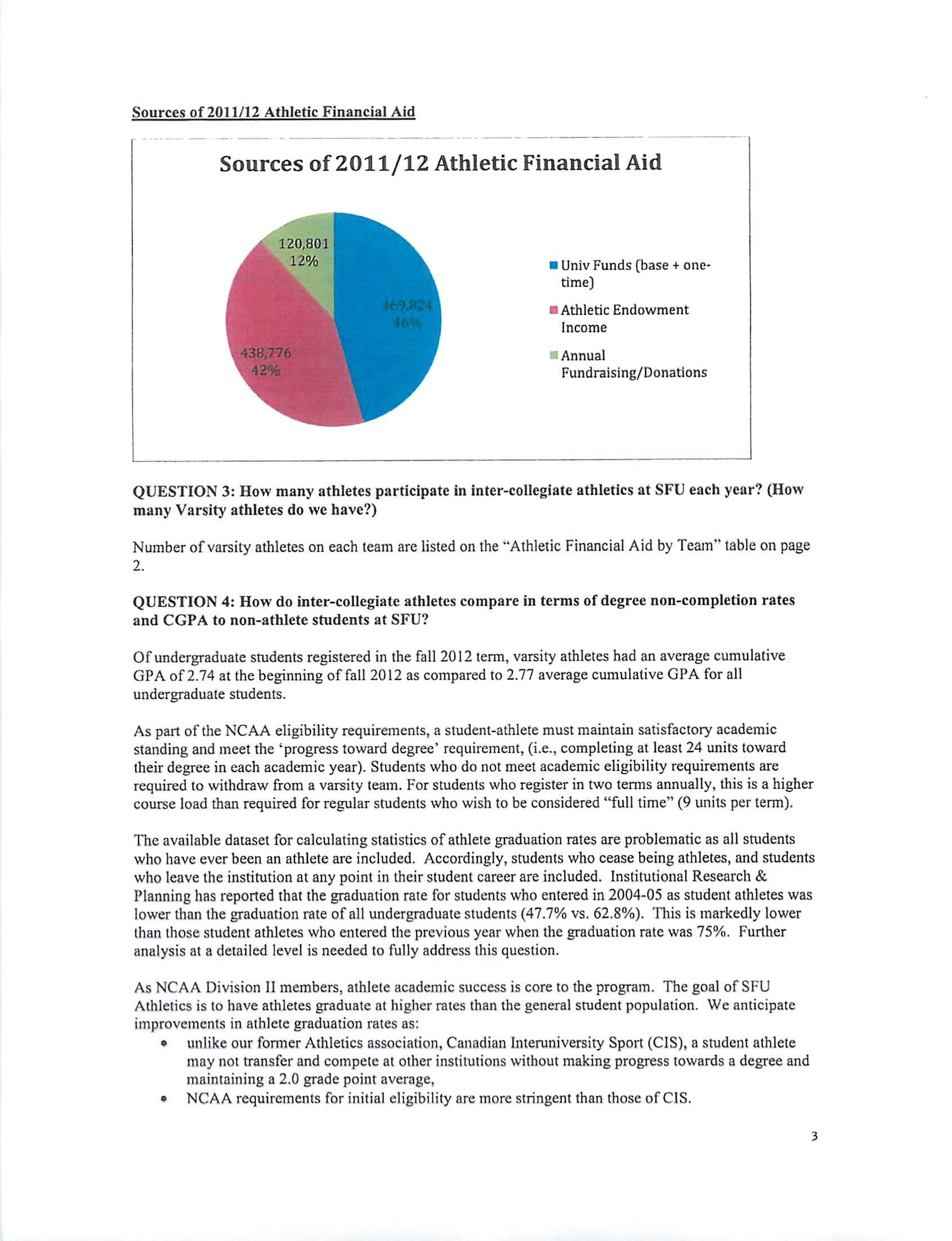S.13-17
SFU
OHFICR OFTHK VICE-PRESIDENT, ACADEMIC AND PROVOST
University Drive, Burnaby, BC
Canada V5A 1S6
TEL 778.782.3925
PAX: 778.782.5876
www.sfu.ca/vpacademic
MEMORANDUM
attention
Senate
date
January 18,2013
FROM
Jon Driver, Vice-President, Academic & Provost
PAGES
1
RE:
Response to Questions from Senator Black
The following questions and comment were submitted by SenatorBlack during the fall 2012 term:
i)
What is the current annual net expenditure on inter-collegiate student athletics at SFU? (This figure should
reflect full cost accounting and therefore include such items as tutors, facilities, all administrative personnel,
coaches, staff, etc.)
2)
What is the current annual expenditure on athletic scholarships (that would not otherwise be awarded on
purely academic grounds)?
3)
How many athletes participate in inter-collegiate athletics at SFU each year? (How many Varsity athletes do
we have?)
4)
How do inter-collegiate athletes compare in terms ofdegree non-completion rates and CGPA to non-athlete
students at SFU?
5)
/
have often heard it said that NCAA membership in particular — but perhaps Varsity sports in general --
renders SFU more attractive to international, premium fee-paying students. Wliat research supports that claim?
Can the value rendered to the University (e.g. the declining numbers ofinternational students we would
experience butfor Varsity sports) be quantified?
Perhaps I should emphasize that I am not opposed to University athletics per sc. I believe, in fact, that
competitive athletics afford excellent trainingfor leadership and cooperation. Sports arc great, and that may
include high-stress, ultra-competitive Varsity sports.
But most good things cost money.
At a time when
Departments are feeling real pain andfinding it difficult to sustain even their core functions, it seems to me that
Senate should reflect on the opportunity cost ofrunning our Varsity sports programs and should use the best
available information when making that evaluation.
Rather than answer each question individually, I thought it might be more useful to provide a short paper
(attached) that I hope provides relevant
answers, and also gives some context for the data.
Attachment (1)
SIMON FRASER UNIVERSITY
ENGAGING THE WORLD
SFU
DEPARTMENT OF ATHLETICS & RECREATION
Student Services
Response to Questions from Senate - January 16, 2013
Simon Fraser University's Athletic operational data is posted annually on the U.S. Department of
Education's Equity in Athletics Data Report website: http://ope.ed.gov/athletics/
The data below corresponds to this public reporting.
QUESTION 1: What is the current annual net expenditure on inter-collegiate student athletics at
SFU? (This figure should reflect full cost accounting and therefore include such items as tutors,
facilities, all administrative personnel, coaches, staff, etc.)
The Athletic & Recreation department's total 2011-12 base budget was $5.9 m. Of the $5.9 m,
approximately S4.5m is from Recreation & Athletic fees collected from registered students
($33.48/$66.96
per student per term). In addition, Athletics also participates in fund-raising activities to
generate additional revenues for operations and athletic scholarships.
Of the $5.9m Athletics & Recreation budget, approximately S2.2 m was assigned to the administration
and maintenance
of the gym facility complex for athletics, recreation and community use; approximately
S2.4m was assigned to support varsity Athletic programming; $580k for services for athletes
(Physiotherapy, Media and Event services) and $742k assigned to support Recreation programming.
2011/12 Athletic
&
Recreation Operational Base
Budget
Facilities/Administration
2,201,876.00
Athletic Team Operation
2,392,476.00
Services for athletes
580,685.00
Recreation
742,766.00
5,917,803.00
Sources of 2011/12 Athletics Team Operating Funds
Sources of 2011/12 Athletic Team Operating Funds
Base Budget
2,392,476
78.45%
Other University Support
294,709
9.66%
Revenues
362,476
11.89%
TOTAL
3,049,661
100%
SIMON PRASEB UNIVERSITY
engaging the world
2011/12 Athletic
Team Expenditure:
2011/12 Athletic Team
Expenditure By Category
68,170
2%
• Coaching Salaries
u Student Recruiting
Expense
Game-Day Expenses
• Other Support
Services
QUESTION 2: What is the current annual expenditure on athletic scholarships (that would not
otherwise be awarded on purely academic grounds)?
2011/12 Athletics Financial Aid
2011/12 Athletic Financial Aid by Team
#
Athletes
Football
278,853
27.09%
96
Men's Basketball
104,728
10.17%
18
Men's Golf
6,512
0.63%
9
Men's Soccer
101,303
9.84%
27
Men's Swimming
74,250
7.21%
13
Men's Track
30,725
2.98%
27
Men's Wrestling
54,720
5.32%
21
Softball
54,033
5.25%
17
Women's Basketball
88,228
8.57%
13
Women's Golf
4,425
0.43%
6
Women's Soccer
46,675
4.53%
22
Women's Swimming
36,720
3.57%
14
Women'sTrack
60,229
5.85%
32
Women's Volleyball
36,000
3.50%
14
Women's Wrestling
52,000
5.05%
18
TOTAL
1,029,401
100.00%
347
Sources of 2011/12 Athletic Financial Aid
Sources of 2011/12 Athletic Financial Aid
•
Univ Funds (base + one
time)
• Athletic Endowment
Income
Annual
Fundraising/Donations
QUESTION 3: How many athletes participate in inter-collegiate athletics at SFU each year? (How
many Varsity athletes do we have?)
Number of varsity athletes on each team are listed on the "Athletic Financial Aid by Team" table on page
2.
QUESTION 4: How do inter-collegiate athletes compare in terms of degree non-completion rates
and CGPA to non-athlete students at SFU?
Of undergraduate studentsregistered in the fall 2012term, varsity athletes had an average cumulative
GPA of 2.74 at the beginning of fall 2012 as compared to 2.77 average cumulative GPA for all
undergraduate students.
As part of the NCAA eligibility requirements, a student-athlete must maintain satisfactory academic
standing and meet the 'progress toward degree' requirement, (i.e., completing at least 24 units toward
their degree in each academic year). Students who do not meet academic eligibility requirements are
required to withdraw from a varsity team. For students who register in two terms annually, this is a higher
course load than required for regular students who wish to be considered "full time" (9 units per term).
The available dataset for calculating statistics of athlete graduation rates are problematic as all students
who have ever been an athlete are included. Accordingly, students who cease being athletes, and students
who leave the institution at any point in their student career are included. Institutional Research &
Planning has reported that the graduation rate for students who entered in 2004-05 as student athletes was
lower than the graduation rate of all undergraduate students
(41.1%
vs. 62.8%). This is markedly lower
than those student athletes who entered the previous year when the graduation rate was
15%.
Further
analysis at a detailed level is needed to fully address this question.
As NCAA Division II members, athlete academic success is core to the program. The goal of SFU
Athletics is to have athletes graduate at higher rates than the general student population. We anticipate
improvements in athlete graduation rates as:
•
unlike
our former Athletics association, Canadian Interuniversity Sport (CIS), a student athlete
may not transfer and
compete at other institutions without making progress towards a degree and
maintaining a 2.0 grade point average,
•
NCAA requirements for initial eligibility are more stringent than those of CIS.
in September 2012 the Department launched a comprehensive student athlete academic support
program headed by Student Success, and
in 2011/12, as required by the NCAA, student athletes have formed a Student Athlete Advisory
Council (SAAC) to provide community service, social, and academic learning opportunities for
student athletes.
QUESTION 5:1 have often heard it said that NCAA membership in particular — but perhaps
Varsity sports in general — renders SFU more attractive to international, premium fee-paying
students.
What research supports that claim? Can the value rendered to the University (e.g. the
declining numbers of international students
we
would experience but for Varsity sports) be
quantified?
NCAA Membership and Recruitment of International Students
As a NCAA member, Simon Fraser gets far more exposure to international audiences,particularly in the
United States, than other BC universities. This past July, when SFU was accepted as the first fully fledged
international member of the NCAA, the story was reported by many news outlets across North America.
Duringour men's soccerrun to the Final Four, theprogram was featured in the New York Times.
Furthermore, this March our men's basketball team will play a nationally televised game on CBS. In
addition to the action on the court, CBS has already plannedto shoot features around the story of SFU
competing in theNCAA in lateJanuary. Wealsoreceive a commercial slot in thebroadcast which willbe
used to promote SFU to the American audience.
In addition to media exposure, it should also be noted that in Fall 2012 SFU has more international
students on our varsity team than any of our counterparts in BritishColumbia who compete in the CIS or
NAIA, see table below. Student-athletes want to compete in the NCAA as it is the most prestigious
collegiate sports organization in North America.
Institution
# of Athletes
# of Intl Athletes
% Intl Athletes
Simon Fraser University
363
52
14.33%
Trinity Western University
166
23
13.86%
Thompson River University
259
29
11.20%
Univ. ofBritish Columbia
558
35
6.27%
Univ. ofNorthern BC
63
4
6.35%
UBC Okanagan
119
5
4.20%
University of Victoria
341
9
2.64%
At this point, we cannot build a direct link between media exposure and recruitment of international
students. More studies need to be done before we can associate SFU'sNCAA membership with the
recruitment or retention ofstudents. However, SFU's participation in NCAA has provided a new avenue
for students to excel outside ofclassroom and enhance their student experience at SFU. Indeed, our
athletes take pride in being the first Canadian school to compete in the NCAA.
Since inception in 1965, the athletic program has produced outstanding athletes and student scholars, such
as Olympic medalists, Rhodes Scholars, etc. Our continued successes rely on continued support from the
University and Campus Communities.
Back to top





